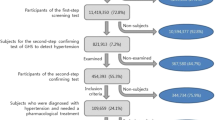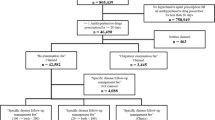Abstract
Background The geographical location and medical facility may affect the pattern of antihypertensive prescriptions. Information regarding the correlation between the prescription and health care faculties in different geographical locations was lacking. Objective The aim of this study was to compare differences in the prescribing of antihypertensives between hospital-based clinics (hospital arm) and office-based clinics (office arm) in different geographical locations in Taiwan. Method We collected data from the National Health Insurance database of Taiwan to carry out a population-based, retrospective cohort analysis of 3,218,794 patients newly diagnosed with hypertension in the period January 1, 1997 to December 31, 2004. Eligible participants were classified into either of two groups based on the level of health care faculty: hospital arm and office arm. The covariates composed of age, gender, antihypertensive regimens, urbanization status, comorbidity, and Charlson comorbidity index. Results There were 2,028,784 cases (63.0 %) for the hospital arm and 1,190,010 (37 %) for the office arm. In the hospital-based arm, there were 168,933 (8.3 %) patients diagnosed with diabetes mellitus, 166,110 (8.2 %) patients diagnosed with coronary artery disease, 147,465 (7.3 %) patients diagnosed with cerebrovascular accident, 86,866 (4.3 %) patients diagnosed with chronic kidney disease, 74,525 (3.7 %) patients diagnosed with benign prostatic hyperplasia, 55,517 (2.7 %) patients diagnosed with congestive heart failure. The all comorbidities in the hospital arm had significantly higher proportions than those in the office arm (p < 0.001). The Charlson comorbidity index in the hospital arm was higher than that in the office arm (p < 0.001). Physicians who practiced in the office arm prescribed polytherapy less often than those in the hospital arm (OR = 0.68, 95 % CI: 0.67–0.68). For overall urbanization status, the adjusted OR of polytherapy prescriptions in the aging city (OR = 1.08, 95 % CI: 1.05–1.12) was higher than other type cities. The highest urbanization-specific OR of polytherapy prescriptions was observed for highly urbanized city in the hospital arm (OR = 1.20, 95 % CI: 1.18–1.23) and aging city in the office arm (OR = 1.42, 95 % CI: 1.21–1.67). In the both arm, patients with lower CCI showed decreased risk of polytherapy prescription. Conclusion The antihypertensive prescriptions in the clinical practices were different between the hospital arm and the office arm in the different health care, comorbidity, and urbanization status. During the study period, the proportion of antihypertensive polytherapy had declined.

Similar content being viewed by others
Abbreviations
- ATC:
-
Anatomic therapeutic chemical
- ACEIs:
-
Angiotensin converting enzyme inhibitors
- ARBs:
-
Angiotensin II receptor blockers
- ABs:
-
α-blockers
- BBs:
-
β-blockers
- BP:
-
Blood pressure
- CCBs:
-
Calcium channel blockers
- CI:
-
Confidence interval
- CCI:
-
Charlson comorbidity index
- HTN:
-
Hypertension
- ICD-9-CM:
-
International classification of disease, ninth revision, clinical modification
- JNC:
-
The Joint National Committee on prevention, detection, evaluation, and treatment of high blood pressure
- NHI:
-
National Health Insurance
- NAHST:
-
Nutrition and Health Survey in Taiwan
- OR:
-
Odds ratio
- SBP/DBP:
-
Systolic blood pressure/diastolic blood pressure
- TwSHHH:
-
The Taiwanese Survey on hypertension, hyperglycemia, and hyperlipidemia
References
Neal B, MacMahon S, Blood Pressure Lowering Treatment Trialists’ Collaboration. Effects of ACE inhibitors, calcium antagonists, and other blood-pressure-lowering drugs: results of prospectively designed overviews of randomized trials. Lancet. 2000;356:1955–64.
Su TC, Bai CH, Chang HY, You SL, Chien KL, Chen MF, et al. Evidence for improved control of hypertension in Taiwan: 1993–2002. J Hypertens. 2008;26:600–6.
Wu PH, Yang CY, Yao ZL, Lin WZ, Wu LW, Chang CC. Relationship of blood pressure control and hospitalization risk to medication adherence among patients with hypertension in Taiwan. Am J Hypertens. 2010;23:155–60.
Bowman MA. Family physicians and internists: differences in practice styles and proposed reasons. J Am Board Fam Pract. 1990;3:43–9.
Al Khaja KA, Sequeira RP, Mathur VS, Damanhori AH, Abdul Wahab AW. Family physicians’ and general practitioners’ approaches to drug management of diabetic hypertension in primary care. J Eval Clin Pract. 2002;8:19–30.
Chiang CW, Chiu HF, Chen CY, Wu HL, Yang CY. Trends in the use of lipid-lowering drugs by outpatients with diabetes in Taiwan, 1997–2003. Pharmacoepidemiol Drug Saf. 2008;17:62–9.
Bureau of National Health Insurance. Introduction of Bureau of National Health Insurance. Accessed online 20 April 2006: http://www.nhi.gov.tw/webdata/webdata.asp?menu=1&menu_id=3&webdata_id=1159.
Department of Health, Executive Yuan. The status and health service statistics summary in Medical institutions in the Republic of China. Accessed online 20 April 2006: http://www.doh.gov.tw/statistic/data.
Charlson ME, Pompei P, Ales KL, MacKenzie CR. A new method of classifying prognostic comorbidity in longitudinal studies: development and validation. J Chronic Dis. 1987;40:373–83.
Liu CY, Hung YT, Chuang YL, Chen YJ, Weng WS, Liu JS, et al. Incorporating development stratification of Taiwan townships into sampling design of large scale health interview survey. J Health Manag. 2006;4:1–22. (in Chinese).
Chen TJ, Chou LF, Hwang SJ. Patterns of ambulatory care utilization in Taiwan. BMC Health Serv Res. 2006;6:54.
Chou CC, Hu KY, Wu NR, Cheng YH, Loh CH, Yeh MK. Changes in drug prescription utilization for diabetic and hypertensive outpatients after initiation of the National Health Insurance’s Global Budget Program in Taiwan. Med Sci Monit. 2008;14:PH33-9.
National Health Insurance Statistical Trend 2001. [cited 2006 Nov 9]. Available from: http://www.nhi.gov.tw/webdata/AttachFiles/Attach_2518_1_3-1-34.pdf.
Chiang TL. Analysis on trends for healthcare expenditures in Taiwan. Taiwan J Public Health. 2003;21:157–63.
Liu PH, Wang JD. Antihypertensive medication prescription patterns and time trends for newly-diagnosed uncomplicated hypertension patients in Taiwan. BMC Health Serv Res. 2008;8:133–44.
Pan WH, Chang HY, Yeh WT, Hsiao SY, Hung YT. Prevalence, awareness, treatment and control of hypertension in Taiwan: results of Nutrition and Health Survey in Taiwan (NAHSIT) 1993–1996. J Hum Hypertens. 2001;15:793–8.
Wen CP, Tsai SP, Chung WS. A 10-year experience with universal health insurance in Taiwan: measuring changes in health and health disparity. Ann Intern Med. 2008;148:258–67.
Report of the Joint National Committee on detection, evaluation, and treatment of high blood pressure. Arch Intern Med. 1988;148:1023–38.
Fifth Report of the Joint National Committee on detection evaluation, treatment of high blood pressure (JNC V). Arch Intern Med. 1993;153:154–83.
Sixth Report of the Joint National Committee on prevention, detection, evaluation, and treatment of high blood pressure. Arch Intern Med. 1997;157:2413-46.
Chobanian AV, Bakris GL, Black HR, Cushman WC, Green LA, Izzo JL Jr, et al. Seventh report of the Joint National Committee on prevention, detection, evaluation, and treatment of high blood pressure. Hypertension. 2003;42:1206–52.
Stafford RS, Monti V, Furberg CD, Ma J. Long-term and short-term changes in antihypertensive prescribing by office-based physicians in the United States. Hypertension. 2006;48:213–8.
Chou CC, Lee MS, Ke CH, Chuang MH. Factors influencing the switch in the use of antihypertensive medications. Int J Clin Pract. 2005;59:85–91.
Wang TJ, Ausiello JC, Stafford RS. Trends in antihypertensive drug advertising, 1985–1996. Circulation. 1999;99:2055–7.
Fretheim A, Oxman AD. International variation in prescribing antihypertensive drugs: its extent and possible explanations. BMC Health Serv Res. 2005;5:21.
Acknowledgments
We would like to thank the National Council of Science and Tri-Service General Hospital. This study is based in part on data from the NHIRD provided by the Bureau of National Health Insurance, Department of Health, and managed by National Health Research Institutes. The interpretation and conclusions contained in this report do not represent those of Bureau of National Health Insurance, Department of Health, or National Health Research Institutes.
Funding
This study was supported by the National Council of Science and Tri-Service General Hospital.
Conflicts of interest
None.
Author information
Authors and Affiliations
Corresponding author
Rights and permissions
About this article
Cite this article
Chen, WL., Kao, TW., Wang, CC. et al. Difference of antihypertensive prescribing between office- and hospital-based clinics in Taiwan. Int J Clin Pharm 34, 710–718 (2012). https://doi.org/10.1007/s11096-012-9664-9
Received:
Accepted:
Published:
Issue Date:
DOI: https://doi.org/10.1007/s11096-012-9664-9




